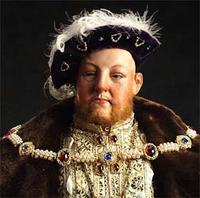
Mr. Stuart has created a large collection of figures depicting the British royals and the high officials whose history is woven intimately with them. The most recognizable and arguably the most notorious is Henry VIII. He was the son of Henry Tudor (Henry VII), the eventual victor of the Wars of the Roses (1455-1485) who consolidated national feeling in England and built a strong, centralized authority.
Louis XIII
In a quest for a male heir, Henry's liasons with six successive wives gave Henry VIII the son he sought but brought a break with Rome. He established the independent Church of England - a Protestant state religion with doctrines determined by temporal powers. Then, he used English anticlericalism to confiscate the Catholic monasteries and with the judicious distribution of that wealth, he secured the allegiance of Parliament.
Following Henry VIII's death in 1547, England experienced religious turbulence under Edward VI, a Protestant, and Mary I, a Catholic. But England emerged as a world power under Henry's daughter Elizabeth I and became the chief bulwark of Protestantism.
At the time of Elizabeth's death, the religious question was still not permanently settled, however. More than a century would pass before the complexities of church and state were resolved.
This web log will feature article abstracts and links to resource material about this famous dynasty, their contemporaries, and the tumultuous period in which they lived.
Image copyright ©2000 by Peter d'Aprix.
